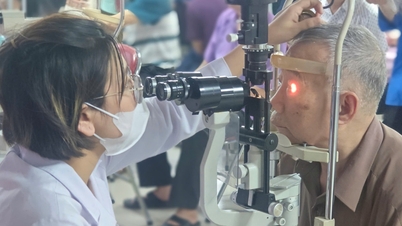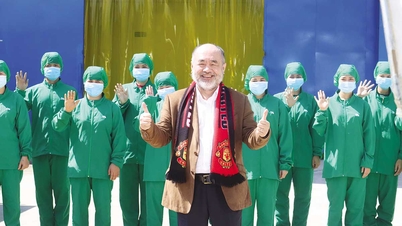The initial symptoms of rhinopharyngitis and flu are similar, such as fever, sore throat, runny nose, dry cough, fatigue... causing many people to mistake rhinopharyngitis for the flu.
The initial symptoms of rhinopharyngitis and flu are similar, such as fever, sore throat, runny nose, dry cough, fatigue... causing many people to mistake rhinopharyngitis for the flu.
According to information from a number of medical facilities, after Tet, the number of patients coming to see a doctor for respiratory diseases increased dramatically, more than 300 cases/day, an increase of more than 30% compared to the changing seasons - the time when rhinopharyngitis "outbreaks".
 |
| Rhinitis and flu are both diseases that are easily contracted when the weather changes suddenly, cold and humid. However, rhinitis often develops slowly while flu develops quickly, suddenly, and has serious complications. |
Symptoms of flu and nasopharyngitis are easily confused because the initial symptoms such as fever, cough, headache, fatigue, runny nose, sneezing, etc. are similar. However, not all fever, cough, and fatigue are flu.
Rhinitis and flu are both diseases that are easily contracted when the weather changes suddenly, cold and humid. However, rhinitis often develops slowly while flu develops quickly, suddenly, and has serious complications.
Influenza is a respiratory infection caused by influenza viruses (virus A, B, C) that infect and attack the respiratory system, nasal passages, throat, bronchi, and lungs. The first common flu symptom is high fever, sudden fever from 39 to 41 degrees Celsius, accompanied by chills, sweating, severe sore throat, sneezing, fatigue, loss of appetite, dry cough, and possibly fainting.
Rhinopharyngitis (also known as a cold) is an acute inflammation of the upper respiratory tract (nose and throat) with symptoms such as sneezing, runny nose, cough, headache or fatigue... caused by many types of viruses, mainly Rhino virus.
Many different causes of nasopharyngitis such as bacterial, viral, fungal, allergen infections. The disease also causes fever but mild fever, usually below 39 degrees Celsius, no chills, no runny nose and stuffy nose like the flu, usually subsides after 10-14 days.
Patients with acute rhinopharyngitis often have headaches and sore throats, runny noses and stuffy noses from time to time, and little sneezing. Meanwhile, patients with influenza A often have severe headaches, muscle aches, body aches, frequent runny noses and stuffy noses, sore noses, and frequent sneezing.
The common psychology of many patients at this time is the fear of catching the flu. Some patients are confused, thinking they have the flu, so the doctor has to reassure and explain carefully.
Like the case of Ms. TLP (35 years old) who is 4 months pregnant, has fever, cough, runny nose, stuffy nose, headache, sore throat, fatigue. Thinking she has a cold, she steamed with herbs, drank lemon and honey... but after 5 days there was no improvement.
She returned to Ho Chi Minh City from her hometown in Ha Nam after the Tet holiday. Hearing about the flu outbreak in the northern provinces, and being pregnant for the first time, she was even more worried. She went to the doctor and asked him many times if she had the flu.
Or like the case of Mrs. HTD (65 years old) who was brought to the clinic by her son because she was afraid of having the flu. She had a history of pneumonia and high blood pressure, so this time she had fever, fatigue, loss of appetite, sore throat, painful swallowing, stuffy nose, runny nose, sneezing, and was lethargic. She had taken medicine for 3 days but had not recovered.
After clinical examination, Mrs. D. was indicated for endoscopy, which was recorded as having acute tonsillitis, pharyngitis, and sinusitis. Mrs. D. was prescribed medication, instructed on home care and monitoring, and scheduled for follow-up visits.
Viral nasopharyngitis is usually benign and usually resolves on its own after 7-10 days. However, if a bacterial infection is present, additional antibiotic treatment is required, otherwise the disease may develop into a serious infection or chronic inflammation.
Rhinopharyngitis is usually milder than the flu and causes less systemic complications, often causing local complications such as inflammation around the throat and tonsils; complications such as sinusitis, otitis media, laryngitis or acute asthma attacks in people with asthma...
On the contrary, flu can cause rapid complications leading to pneumonia, sepsis, septic shock, respiratory failure and death, especially in the elderly, children and people with underlying diseases.
Master, Doctor CK1 Pham Thai Duy, ENT Center, Tam Anh General Hospital, Ho Chi Minh City, explains that at this time, many people have nose and throat diseases because they have just returned from the Central and Northern regions to their hometowns to celebrate Tet, and have returned to the South for about 7-10 days.
The weather in these provinces is cold and rainy during the Tet holidays (15-20 degrees Celsius), weakening the physiological activities of the nose and throat. The sudden change of residence (from the South to the North and then back to the South) leads to new exposure to allergens and other bacteria that the body has no immunity to, along with many other favorable conditions such as irregular living schedule, spicy food, alcohol, etc. during the last Tet holiday, causing upper respiratory tract infections.
Not to mention, during Tet, people get sick but are afraid to go to the doctor, take medicine by themselves, wait until after Tet to go to the doctor. At the same time, the flu epidemic is raging, the number of flu cases is increasing, so many patients are afraid of getting the flu when they have symptoms of fever, runny nose, sore throat, stuffy nose, cough... Those are the reasons why the number of patients increases.
“Clinically, some cases are difficult to distinguish. If flu is suspected, to be sure, the patient needs to test for influenza A and influenza B viruses, which Tam Anh General Hospital has been performing on many patients in recent days,” said Dr. Duy.
The treatment of flu and nasopharyngitis is different. Flu is not treated with antibiotics, because antibiotics do not kill the virus that causes the disease. Rhinopharyngitis is treated with antibiotics depending on the case of bacteria or the presence of a secondary infection.
Because of the different treatments, patients should not self-diagnose or buy medicine without a doctor's prescription. This will not only not help the disease get better, but will also make it worse, leading to dangerous complications, especially if they have the flu. Patients should closely monitor symptoms, differentiate between the two diseases, not panic and not be subjective about the disease.
To prevent the disease at this time, Dr. Duy recommends that everyone wear masks when going out, clean their nose and throat regularly, keep their throat warm when going out, drink warm water instead of cold water, limit spicy foods, and drink two liters of water per day.
Get enough sleep, maintain a healthy lifestyle, and exercise to improve your immune system. People with symptoms such as sore throat, hoarseness, mild fever, and runny nose lasting more than 3-5 days should see a doctor early to avoid complications.
Source: https://baodautu.vn/viem-mui-hong-de-nham-voi-cum-d246867.html


![[Photo] Prime Minister Pham Minh Chinh receives United Nations Secretary-General Antonio Guterres](https://vphoto.vietnam.vn/thumb/1200x675/vietnam/resource/IMAGE/2025/10/25/1761390212729_dsc-1484-jpg.webp)
![[Photo] Prime Minister Pham Minh Chinh and United Nations Secretary-General Antonio Guterres attend the Press Conference of the Hanoi Convention Signing Ceremony](https://vphoto.vietnam.vn/thumb/1200x675/vietnam/resource/IMAGE/2025/10/25/1761391413866_conguoctt-jpg.webp)
![[Photo] National Assembly Chairman Tran Thanh Man receives United Nations Secretary-General Antonio Guterres](https://vphoto.vietnam.vn/thumb/1200x675/vietnam/resource/IMAGE/2025/10/25/1761390815792_ctqh-jpg.webp)

























![[Photo] General Secretary To Lam meets with General Secretary and President of Laos Thongloun Sisoulith](https://vphoto.vietnam.vn/thumb/1200x675/vietnam/resource/IMAGE/2025/10/25/1761380913135_a1-bnd-4751-1374-7632-jpg.webp)









































































Comment (0)